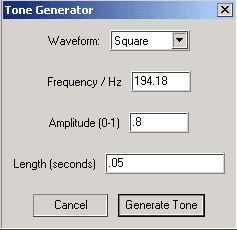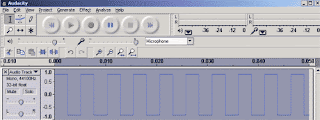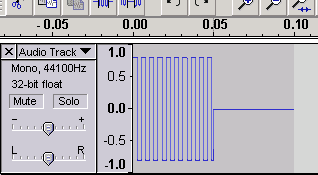Now let's start creating isochronic tones with square waves. If you haven't read the first part of this series, here is the link (opens in a new window):
How To Make Create Isochronic Tones - Start Here
What we need now is to select the pitch of the tone. Since this is the start or the beginning of our creation, let's make the pitch correspond to the frequency of the root chakra to make it meaningful and reap the benefits of activating that chakra. Discussion about the chakras is beyond the scope of this post, so you'll have to do your own research about that.
The next thing we need is the isochronic frequency. Let's use the alpha wave of 10hz (cycles per second) for this project as this is the safest frequency to entrain our brain. Alpha waves are very relaxing and can re-energize your mind and body. You can read more about brainwave frequencies at: (opens in a new window)
http://www.lunarsight.com/freq.htm
Calculating the half cycle of isochronic tone
One full cycle of an isochronic tone is the length of the tone plus a silence (no tone) of the same length. At 10hz, the tone will sound 10 times alternating with silence. So the components of 1 cycle is 1/2 tone and 1/2 silence - 10hz would mean 10 full cycles in 1 second. The calculation for the half cycle is:
1/20 = 0.05 seconds
Now we have this data:
- tone pitch = 194.18 (root chakra frequency)
- isochronic frequency = 10hz (alpha waves)
- half cycle = 0.05 seconds
Let's start the actual creation. Open up the audacity audio editor software. If you have familiarized yourself with the software, following the instructions below will be easy.
1. Click Generate/Tone..
2. Enter the data you see in the image below:

3. Click Generate Tone. You'll see the following waveform:

As you can see the whole length of the tone (0.05hz) occupies the whole track. You can adjust the display to your needs by zooming in our out. Here are the menu and keyboard equivalents:
| FUNCTION | MENU | KEYBOARD SHORTCUT |
| zoom in | View/Zoom In | Ctrl+1 |
| zoom out | View/Zoom Out | Ctrl+3 |
| normal | View/Zoom Normal | Ctrl+2 |
4. Generating silence
The silence or no sound portion should be the same length as the tone. Go to the end of the track by clicking Edit/Move Cursor../to Track End. The keyboard shortcut is the End key.
Now that we have the cursor at the track end, it's now to insert silence of the same duration (0.05 sec.). Click Generate/Silence... and a dialogue box would prompt you for the length of silence in seconds. Enter ".05" without the quotes then click Generate Silence. Zoom out the track and you'll see the waveform like the image below.
 Now you have created one cycle (full wave) of the tone. The tone and the silence are of equal duration. What we have to do know is replicate that waveform until we reach the desired amount of time.
Now you have created one cycle (full wave) of the tone. The tone and the silence are of equal duration. What we have to do know is replicate that waveform until we reach the desired amount of time.5. Replicating the full wave
Select all of the items in the track by clicking Edit/Select All. The keyboard equivalent is Ctrl+a. Now that the whole cycle is selected, copy it to the clipboard by clicking Edit/Copy - keyboard equivalent is Ctrl+c.
Bring the cursor to the track end by pressing the end key then paste the contents of the keyboard by clicking Edit/Paste or pressing Ctrl+v. Do this sequence 9 times to create a 1 second tone.
Copy all of the 1 second tone to the clipboard and paste it 9 times to get a 10 second tone.
Copy the the 10 second tone to the clipboard and paste it 5 times to get a 1 minute tone and so on....
6. How long should the tone be?
Studies have should that you can entrain your brainwaves to a specific frequency within 6 minutes depending on where you brainwave was pulsating before you started listing to the isochronic tone. If you are already relaxed when you start listening, your brainwave can be entrained earlier compared to being in an active state before the start. 15 minutes is a good length of time for relaxing purposes.
After you have created your desired length of isochronic tones, you can now export it as a .wav file. Click File/Export as Wav.. A dialogue box will prompt you for a filename and the location for the file.
Does it sound nice?
Frankly speaking - tot tot tot tot tot is not so pleasant to hear but our purpose is entraining our brain to pulse to a desired frequency. Isochronic tones are effective in brainwave entrainment so just listen to the beat whether its pleasant to you or not. It's just 15 minutes and you reap the benefits of that particular brainwave frequency.
What do you get out of listening to isochronic tones?
Different brainwave frequencies have different benefits for our mind and body. What we just did was to create an isochronic tone of 10hz. It's in the alpha range which can calm and relax your body relieving you of stress. There are also other benefits of this frequency such as lesser or no worries because the conscious mind is silenced a bit and the subconscious mind is a bit activated (an entry point to our deeper consciousness). This is a very good frequency to start with which you can reach in only several minutes. If you have tried meditation, you know how hard it is to maintain this state of mind - a little relaxed and a little active. You will either fall asleep or not reach the alpha state at all. Meditation really requires practice and a lot of time to achieve whereas isochronic tones can give you a shortcut to achieve that state. I'll make post about meditation later.
How to listen to isochronic tones
To achieve best results, you must set a time that you will not be disturbed for the duration of the session. If you have some urgent thing to do and insert an isochronic tone session, you wouldn't likely achieve the desired state due to the preoccupation in your mind. Set the stage for a relaxing state and you're more likely to benefit from the session.
Sit comfortably with back straight but not rigid like the military pose. Take a deep breathe before starting the session. Better still, inhale deeply and forcefully exhale as much air as possible. When the session is started, try to breathe evenly and regularly and maintain it for the rest of the session.
Just like meditation, listening to isochronic tones can be passive (receptive) or active depending on what you want. In the receptive mode, you just listen, hear, feel or experience whatever sensation you will encounter in that state without judgment. Just observe the stream of thoughts going on in your mind, you'll be amazed to discover how much activities are going on just below the surface of your conscious mind. We'll talk about the active mode in a later post.
How do you know if you have reached the alpha state?
Only you will know when you are there. It differs from person to person. Others feel a swaying of their body while others experiencing a pulsing sensation. You'll know it because it's unlike your waking state. If you feel like sleeping, just focus on the tone and it will pull you back to the alpha state.
Making the tones more pleasant to hear
In a later post, I'll show you how to enhance the waveform so as to make it more pleasant to the ear. Meanwhile try what you have just created for several days to get you in tune to the 10hz alpha state. It's best to start with the passive mode to make yourself get really acquainted with the alpha state. Set the volume to a level that is most comfortable to you.
Happy listening and may you benefit from it. If you want to share your experience, express it in the comment form. Thanks.
Hi, thanks for this "How-to" on making isochronic tones; I have done both projects on Alpha waves using Audacity. However, I've been trying to research the frequencies of the chakras and cannot find a consensus on them. Could you please give us your "source" for the information on the ROOT CHAKRA FREQUENCY, etc.?
ReplyDeleteI look forward to learning how to RAMP, etc. and make my own tones to self-program while I'm sleeping.
Thank you.
Danny Dwinell
Seattle, WA
Hi This one of the useful article about the BWE. Please post about how to embed affirmations in isochronic tones which you have mentioned in earlier post. Eagerly awaiting for this.
ReplyDeleteThank you
shruthi
what is a charka ? I look for it in the menu bar of the application & can't seem to find it anywhere. this is cool by the way, I use neo programmer And it's nice to know how to do my own tones. I use this mostly for energy/exercise...it works so nuch better then coffee.
ReplyDeleteInformation regarding the chakra can be found here:
ReplyDeletehttp://en.wikipedia.org/wiki/Chakra
You must be entraining for the beta frequencies to get your energies up. It certainly is better than coffee.
However, too much beta entrainment can bring your stress hormones to high levels so it would be better to counter it with the lower brainwave frequencies at the end of the day to relax you. Doing so can lower your stress level and give you a good night's rest.
There's an easier way to do this now, and it even supports ramping. Just grab the isochronic modulator plugin from here:
ReplyDeletehttp://forum.audacityteam.org/viewtopic.php?f=39&t=39487&p=104905#p104905
Thank you Douglas for making life easier!
ReplyDelete---
ReplyDeleteWith this plug-in is possible to create Sine Isochronic Tones:
http://forum.audacityteam.org/viewtopic.php?f=39&t=41423
---
Thanks for sharing GendeDios.
ReplyDeleteSo lets say I want to make a 1hz Delta Isochronic tone. I know that i would use the equation 1/(1*2) but does it matter what frequency I make it because you put in 194.18. Do I need to make it different if I make it for Beta, Theta, Delta, etc. beats?
ReplyDeleteAnd what about the amplitude as well, Thank you
ReplyDelete